Double Loop Network for Combined Heating and Cooling in Low Heat Density Areas
Abstract
1. Introduction
1.1. State of the Art and Future Challenges
1.1.1. Reduction of Distribution Losses and Implementation of Ultra-Low-Temperature
1.1.2. DHW Preparation without Any Risk of Legionella
1.1.3. Improved Design for Supply Heat during Summer and No-Load Periods
1.1.4. Improved Distribution Network
1.1.5. Integration of Heating, Cooling, and Electricity
1.2. Aim and Novelty of the Investigation
2. Double Loop Network
2.1. General Concept Description
2.2. The Role of the Main Pumps
2.3. Local Pumps
2.4. Connection of Clusters of Houses to the Main Loop
2.5. End-Users’ Substations and Connection to the Network
2.6. Connection of Decentralized Energy Sources
2.7. Assumptions
3. Methods and Data
3.1. Network Design and Operation
3.1.1. Design Load for the Network
3.1.2. Design Mass Flow Rate and Pipe Dimensioning
3.1.3. Network Annual Energy Consumption
3.1.4. Optimization of Summer Circulation Flow
3.1.5. Capital and Operating Costs
4. Simulated Case Studies
4.1. Case 1: Double Loop Network with HPs and Waste Heat Recovery
4.2. Case 2: Double Loop Network with Large ASHPs
4.3. Case 3: Tree Network with ASHP
4.4. Case 4: Individual Heating Solutions Based on Heat Pumps
5. Results and Discussion
5.1. Network Design and Hydraulics
5.2. Energy Analysis of Simulation Cases
5.3. Cost Analysis of Simulation Cases
5.4. Summer Circulation Flow
5.5. Impact of Recovering Excess Heat
5.6. Micro Tanks on the Primary Side for DHW Preparation
5.7. Cooling Operation of the Double Loop
6. Conclusions
Author Contributions
Funding
Acknowledgments
Conflicts of Interest
Nomenclature
| List of Symbols and Acronyms | |
| DH | District heating |
| DC | District Cooling |
| LTDH | Low-temperature district heating |
| 4GDH | 4th generation district heating |
| 5GDHC | 5th generation district heating and cooling |
| EED | Energy Efficiency Directive |
| EPBD | Energy Performance of Buildings Directive |
| ΔT | Temperature difference between supply and return (°C) |
| SH | Space heating |
| DHW | Domestic hot water |
| R/S | Return/supply connection of decentralized energy source |
| R/R | Return/return connection of decentralized energy source |
| COP | Coefficient of performance |
| HP | Heat pump |
| cp | Specific heat capacity of water (kJ/kg °C) |
| Ts | Supply temperature (°C) |
| Tr | Return temperature (°C) |
| Mass flow rate (kg/s) | |
| ASHP | Air source heat pump |
| WSHP | Water source heat pump |
| HS | Heat Source |
| LMTD | Logarithmic mean temperature difference |
| DPC | Differential pressure controller |
| CHV | Check valve |
| TMV | Thermostatic valve |
References
- European Commission. An EU Strategy on Heating and Cooling 2016. Available online: https://ec.europa.eu/energy/en/topics/energy-efficiency/heating-and-cooling (accessed on 10 August 2018).
- European Commission. Energy Efficiency Directive 2018/2002/EU 2018. Available online: https://ec.europa.eu/energy/topics/energy-efficiency/targets-directive-and-rules/energy-efficiency-directive_en#content-heading-0 (accessed on 15 August 2020).
- European Commision. Energy Performance of Buildings Directive (EU 2018/844) 2018. Available online: https://ec.europa.eu/info/news/new-energy-performance-buildings-directive-comes-force-9-july-2018-2018-jun-19_en (accessed on 15 August 2020).
- Frederiksen, S.; Werner, S. District Heating and Cooling; Studentlitteratur: Sweden, 2013; 408p. [Google Scholar]
- Werner, S. International review of district heating and cooling. Energy 2017, 137, 617–631. [Google Scholar] [CrossRef]
- Lund, H.; Werner, S.; Wiltshire, R.; Svendsen, S.; Thorsen, J.E.; Hvelplund, F.; Mathiesen, B.V. 4th Generation District Heating (4GDH): Integrating smart thermal grids into future sustainable energy systems. Energy 2014, 68, 1–11. [Google Scholar] [CrossRef]
- Lund, H.; Østergaard, P.A.; Chang, M.; Werner, S.; Svendsen, S.; Sorknæs, P.; Thorsen, J.E.; Hvelplund, F.; Mortensen, B.O.; Mathiesen, B.V.; et al. The status of 4th generation district heating: Research and results. Energy 2018, 164, 147–159. [Google Scholar] [CrossRef]
- Østergaard, D.S.; Svendsen, S. Theoretical overview of heating power and necessary heating supply temperatures in typical Danish single-family houses from the 1900s. Energy Build. 2016, 126, 375–383. [Google Scholar] [CrossRef]
- Tunzi, M.; Østergaard, D.S.; Svendsen, S.; Boukhanouf, R.; Cooper, E. Method to investigate and plan the application of low temperature district heating to existing hydraulic radiator systems in existing buildings. Energy 2016, 113, 413–421. [Google Scholar] [CrossRef]
- Østergaard, D.S.; Svendsen, S. Case study of low-temperature heating in an existing single-family house—A test of methods for simulation of heating system temperatures. Energy Build. 2016, 126, 535–544. [Google Scholar] [CrossRef]
- Østergaard, P.A.; Andersen, A.N. Booster heat pumps and central heat pumps in district heating. Appl. Energy 2016, 184, 1374–1388. [Google Scholar] [CrossRef]
- David, A.; Mathiesen, B.V.; Averfalk, H.; Werner, S.; Lund, H. Heat Roadmap Europe: Large-Scale Electric Heat Pumps in District Heating Systems. Energies 2017, 10, 578. [Google Scholar] [CrossRef]
- Ommen, T.; Markussen, W.B.; Elmegaard, B. Lowering district heating temperatures—Impact to system performance in current and future Danish energy scenarios. Energy 2016, 94, 273–291. [Google Scholar] [CrossRef]
- Werner, S. District heating and cooling in Sweden. Energy 2017, 126, 419–429. [Google Scholar] [CrossRef]
- Wiechers, E.; Persson, U.; Grundahl, L.; Connolly, D.; Bernd, M. Heat Roadmap Europe: Identifying local heat demand and supply areas with a European thermal atlas. Energy 2018, 158, 281–292. [Google Scholar] [CrossRef]
- Werner, S. European space cooling demands. Energy 2016, 110, 148–156. [Google Scholar] [CrossRef]
- District Energy—Energy Efficiency for Urban Areas. State of Green 2018. Available online: https://stateofgreen.com/en/uploads/2018/08/SoG_WhitePaper_DistrictEnergy_210x297_V22_WEB.pdf?time=1595944516 (accessed on 20 July 2020).
- Calderoni, M.; Dourlens-Qaranta, S.; Sreekumar, B.B.; Lennard, Z.; Rämä, M.; Klobut, K.; Wang, Z.; Duan, X.; Zhang, Y.; Nilsson, J.; et al. Sustainable District Cooling Guidelines; IEA DHC/CHP Report 2019. Available online: http://www.euroheat.org/wp-content/uploads/2020/07/IEA_DHC_Annex_XII_Sustainable_District_Cooling_Guidelines_Excerpt.pdf (accessed on 19 June 2020).
- European Commission. Developments and Forecasts on Continuing Urbanisation 2018. Available online: https://ec.europa.eu/knowledge4policy/foresight/topic/continuing-urbanisation/developments-and-forecasts-on-continuing-urbanisation_en (accessed on 1 September 2020).
- The City of Copenhagen. CPH 2025 Climate Plan: Roadmap 2017–2020 2017:64. Available online: https://urbandevelopmentcph.kk.dk/artikel/cph-2025-climate-plan (accessed on 1 September 2020).
- UNEP. District Energy in Cities: Unlocking the Potential of Energy Efficiency and Renewable Energy; United Nations Environment Programme: Nairobi, Kenya, 2015. [Google Scholar]
- Åberg, M.; Fälting, L.; Lingfors, D.; Nilsson, A.M.; Forssell, A. Do ground source heat pumps challenge the dominant position of district heating in the Swedish heating market? J. Clean Prod. 2020, 254, 120070. [Google Scholar] [CrossRef]
- Hansen, C.H.; Gudmundsson, O. The Competitiveness of District Heating Compared to Individual Heating. When is District Heating the Cheapest Source of Heating? 2018. Available online: https://www.danskfjernvarme.dk/-/media/danskfjernvarme/%0Agronenergi/analyser/03052018-the-competitiveness-of-district-heatingcompared-%0Ato-individual-heatingv2.pdf (accessed on 19 August 2020).
- Danish Standards Assosciation. DS 439:2009 “Norm for vandinstallationer (Code of Practice for domestic water supply)” 2009. Available online: https://webshop.ds.dk/da-dk/standard/ds-4392009 (accessed on 13 March 2020).
- Yang, X.; Li, H.; Svendsen, S. Evaluations of different domestic hot water preparing methods with ultra-low-temperature district heating. Energy 2016, 109, 248–259. [Google Scholar] [CrossRef]
- Yang, X.; Li, H.; Svendsen, S. Decentralized substations for low-temperature district heating with no Legionella risk, and low return temperatures. Energy 2015, 110, 65–74. [Google Scholar] [CrossRef]
- Yang, X.; Li, H.; Svendsen, S. Energy, economy and exergy evaluations of the solutions for supplying domestic hot water from low-temperature district heating in Denmark. Energy Convers. Manag. 2016, 122, 142–152. [Google Scholar] [CrossRef]
- Thorsen, J.E.; Ommen, T. Field experience with ULTDH substation for multifamily building. Energy Procedia 2018, 149, 197–205. [Google Scholar] [CrossRef]
- Averfalk, H.; Werner, S. Novel low temperature heat distribution technology. Energy 2018, 145, 526–539. [Google Scholar] [CrossRef]
- Averfalk, H.; Ottermo, F.; Werner, S. Pipe sizing for novel heat distribution technology. Energies 2019, 12, 1276. [Google Scholar] [CrossRef]
- Brand, M.; Rosa, A.D.; Svendsen, S. Energy-efficient and cost-effective in-house substations bypass for improving thermal and DHW (domestic hot water) comfort in bathrooms in low-energy buildings supplied by low-temperature district heating. Energy 2014, 67, 256–267. [Google Scholar] [CrossRef]
- Lennermo, G.; Lauenburg, P.; Werner, S. Control of decentralised solar district heating. Sol. Energy 2019, 179, 307–315. [Google Scholar] [CrossRef]
- Brand, L.; Calvén, A.; Englund, J.; Landersjö, H.; Lauenburg, P. Smart district heating networks—A simulation study of prosumers’ impact on technical parameters in distribution networks. Appl. Energy 2014, 129, 39–48. [Google Scholar] [CrossRef]
- Rämä, M.; Wahlroos, M. Introduction of new decentralised renewable heat supply in an existing district heating system. Energy 2018, 154, 68–79. [Google Scholar] [CrossRef]
- Hassine, I.B.; Eicker, U. Control aspect of decentralized solar thermal integration into district heating networks. Int. Conf. Sol. Heat. Cool. Build. Ind. 2014, 48, 1055–1064. [Google Scholar] [CrossRef]
- Hassine, I.B.; Eicker, U. Impact of load structure variation and solar thermal energy integration on an existing district heating network. Appl. Therm. Eng. 2013, 50, 1437–1446. [Google Scholar] [CrossRef]
- Lennermo, G.; Lauenburg, P.; Brand, L. Decentralized heat supply in district heating systems—Implications of varying differential pressure. In Proceedings of the 14th International Symposium on DH and Cooling, Stockholm, Sweden, 7–9 September 2014. [Google Scholar]
- Kuosa, M.; Kontu, K.; Mäkilä, T.; Lampinen, M.; Lahdelma, R. Static study of traditional and ring networks and the use of mass flow control in district heating application. Appl. Therm. Eng. 2013, 54, 450–459. [Google Scholar] [CrossRef]
- Kuosa, M.; Aalto, M.; Assad, M.E.; Mäkilä, T.; Lampinen, M.; Lahdelma, R. Study of a district heating system with the ring network technology and plate heat hexchangers in a consumer substation. Energy Build. 2014, 80, 276–289. [Google Scholar] [CrossRef]
- Tol, H.I.; Svendsen, S. Improving the dimensioning of piping networks and networks layouts in low-energy distrct heating systems connected to low-energy buildings: A case study in Roskilde, Denmark. Energy 2012, 38, 276–290. [Google Scholar] [CrossRef]
- Tol, H.I.; Svendsen, S. Effects of boosting the supply temperature on pipe dimensions of low-energy district heating networks: A case study in Gladsaxe, Denmark. Energy Build. 2015, 88, 324–334. [Google Scholar] [CrossRef]
- Tol, H.İ. District Heating in Areas with Low Energy Houses; Techical University of Denmark: Lynby, Denmark, 2015. [Google Scholar]
- Buffa, S.; Cozzini, M.; D’Antoni, M.; Baratieri, M.; Fedrizzi, R. 5th generation district heating and cooling systems: A review of existing cases in Europe. Renew. Sustain. Energy Rev. 2019, 104, 504–522. [Google Scholar] [CrossRef]
- Bünning, F.; Wetter, M.; Fuchs, M.; Müller, D. Bidirectional low temperature district energy systems with agent-based control: Performance comparison and operation optimization. Appl. Energy 2018, 209, 502–515. [Google Scholar] [CrossRef]
- FLEXYNET Project 2018. Available online: http://www.flexynets.eu/en/ (accessed on 19 June 2020).
- Cozzini, M.; Trier, D.; Bava, F.; Fedrizzi, R.; Buffa, S.; Jensen, L.L.; Hussein, A. FLEXYNETS Guide Book; 2018. Available online: https://w4u0es9f4.wimuu.com/Download?id=file:57483900&s=6148206224655629506 (accessed on 19 June 2020).
- ReUseHeat Project. Handbook: 24 Cases of Urban Waste Heat Recovery n.d. Available online: https://celsiuscity.eu/excess-heat-from-cooling-at-grundfos-in-bjerringbro-denmark/ (accessed on 19 June 2020).
- Danish Standards. Danish Standards DS 418: 2020 Building Regulations 2020. Available online: https://bygningsreglementet.dk/ (accessed on 13 March 2020).
- Christensen, M.H.; Li, R.; Pinson, P. Demand side management of heat in smart homes: Living-lab experiments. Energy 2020, 195, 116993. [Google Scholar] [CrossRef]
- Vela Solaris. PolySun—Holistic Energy System Simulations for Building and District Planners n.d. Available online: https://www.velasolaris.com/?lang=en (accessed on 19 March 2020).
- Braas, H.; Jordan, U.; Best, I.; Orozaliev, J.; Vajen, K. District heating load pro fi les for domestic hot water preparation with realistic simultaneity using DHWcalc and TRNSYS. Energy 2020, 201, 117552. [Google Scholar] [CrossRef]
- Guo, X.; Pascal, A. Air source heat pump for domestic hot water supply: Performance comparison between individual and building scale installations. Energy 2018, 164, 794–802. [Google Scholar] [CrossRef]
- Persson, U.; Werner, S. Quantifying the Heating and Cooling Demand in Europe–WP 2–Background Report 4 2015:25. Available online: https://heatroadmap.eu/wp-content/uploads/2018/09/STRATEGO-WP2-Background-Report-4-Heat-Cold-Demands.pdf (accessed on 2 June 2020).
- Danish Energy Agency. Techonology Data: Generation of Electricity and District Heating 2020. Available online: https://ens.dk/sites/ens.dk/files/Statistik/technology_data_catalogue_for_el_and_dh_-_0009.pdf (accessed on 2 February 2020).
- Danish Energy Agency. Technology Data: Heating Installations 2016. Available online: https://ens.dk/sites/ens.dk/files/Analyser/technology_data_catalogue_for_individual_heating_installations.pdf (accessed on 2 February 2020).
- EUROSTAT. Electricity Price Statitics 2020. Available online: https://ec.europa.eu/eurostat/statistics-explained/index.php/Electricity_price_statistics (accessed on 2 February 2020).
- Østergaard, P.A.; Andersen, A.N. Economic feasibility of booster heat pumps in heat pump-based district heating systems. Energy 2018, 155, 921–929. [Google Scholar] [CrossRef]
- Hansen, C.H.; Gudmundsson, O.; Detlefsen, N. Cost efficiency of district heating for low energy buildings of the future. Energy 2019, 177, 77–86. [Google Scholar] [CrossRef]
- Peteri, B.V. Quooker Energy Analysis 2010:61. Available online: https://kokendwaterkranen.com/wp-content/uploads/2015/09/Quooker-energieverbruik-onderzoek.pdf (accessed on 7 March 2020).
- DS/CEN/TR16355. Recommendations for Prevention of Legionella Growth in Installations Inside Buildings Conveying Water for Human Consumption; CEN: Copenhagen, Denmark, 2012. [Google Scholar]
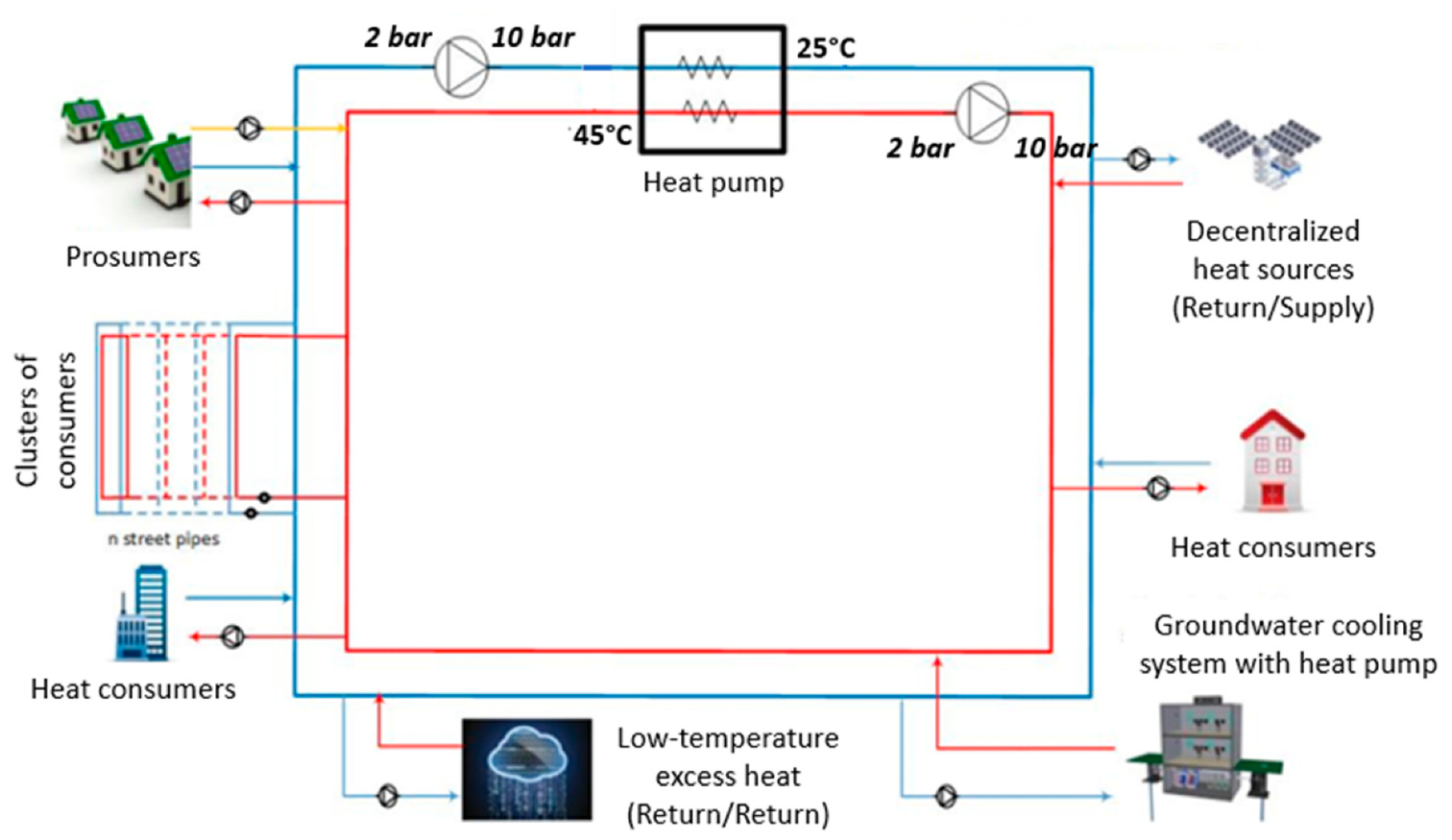
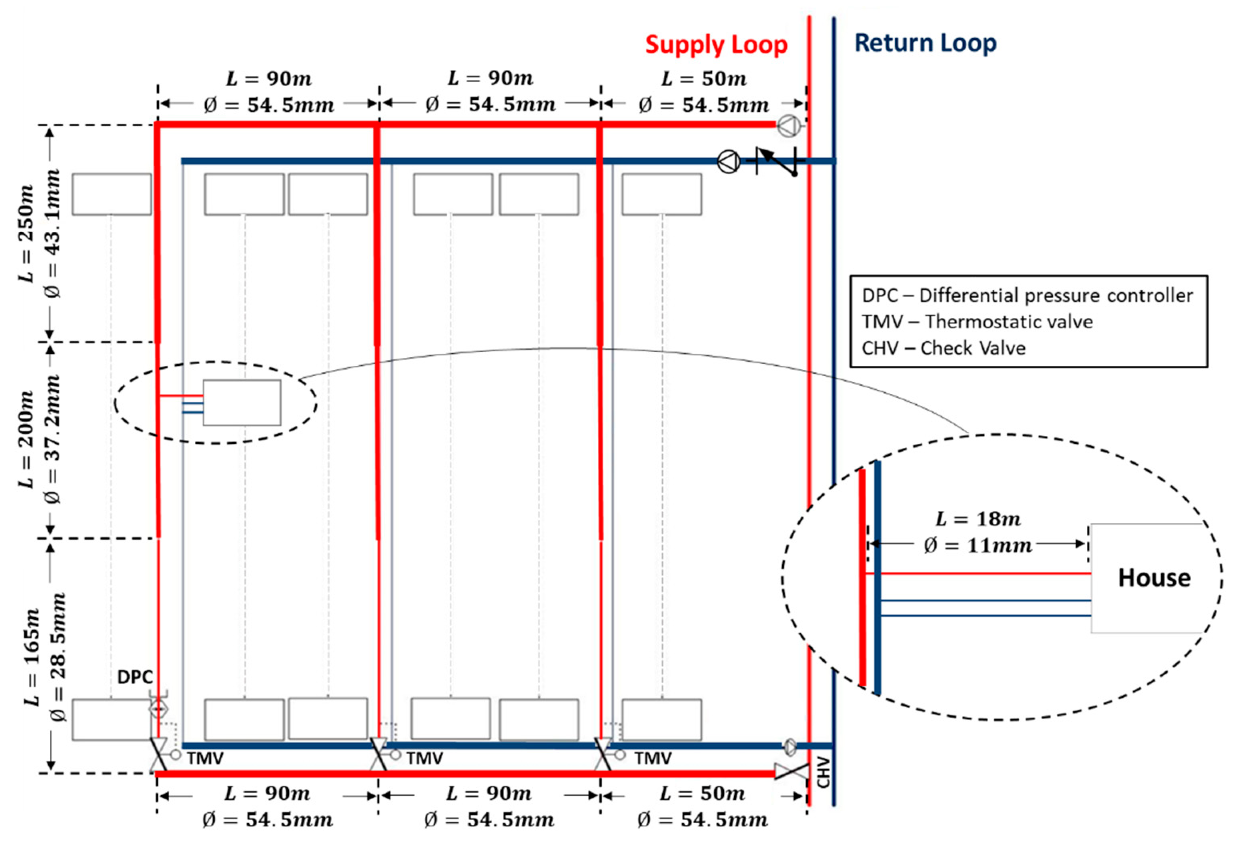

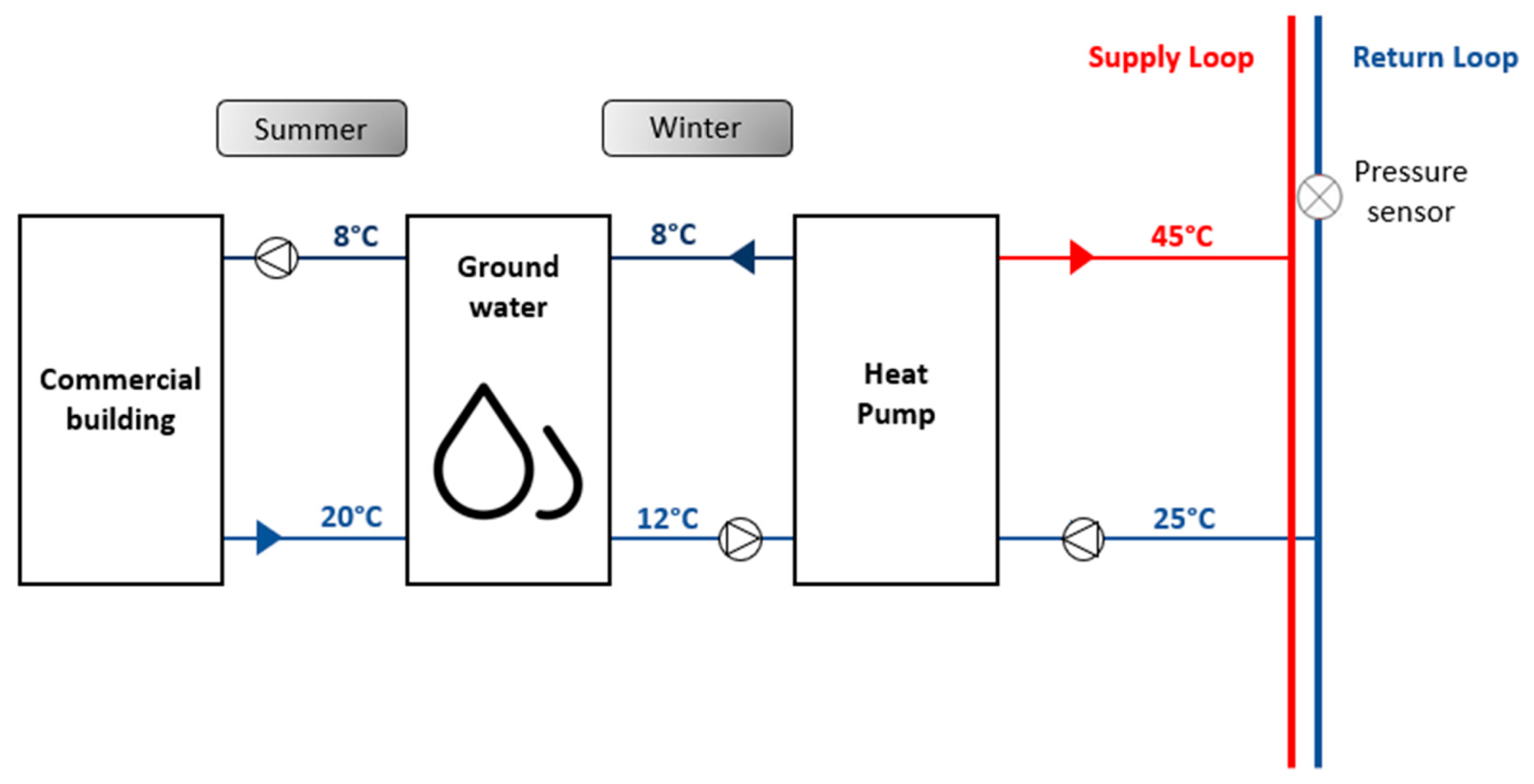
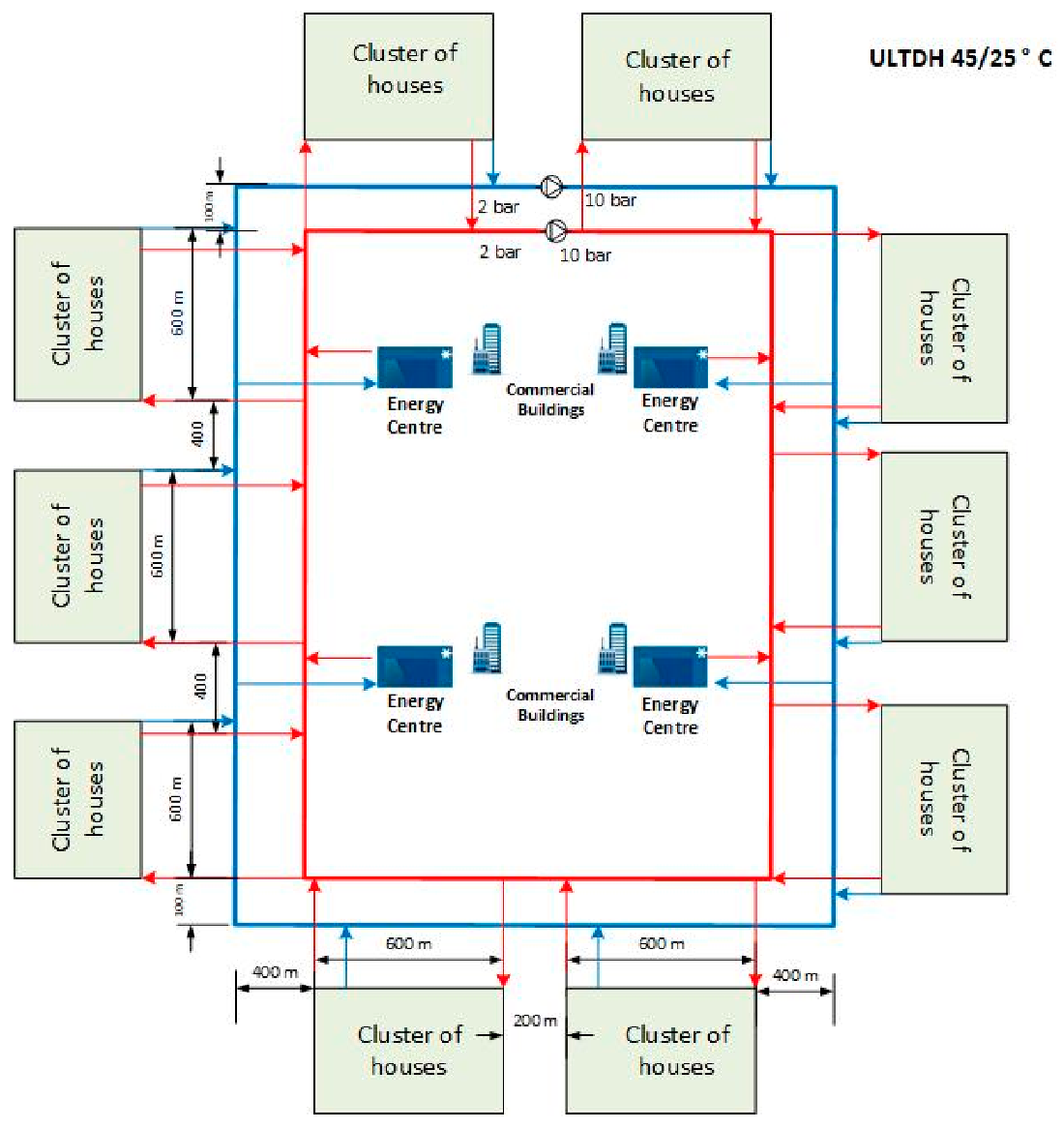
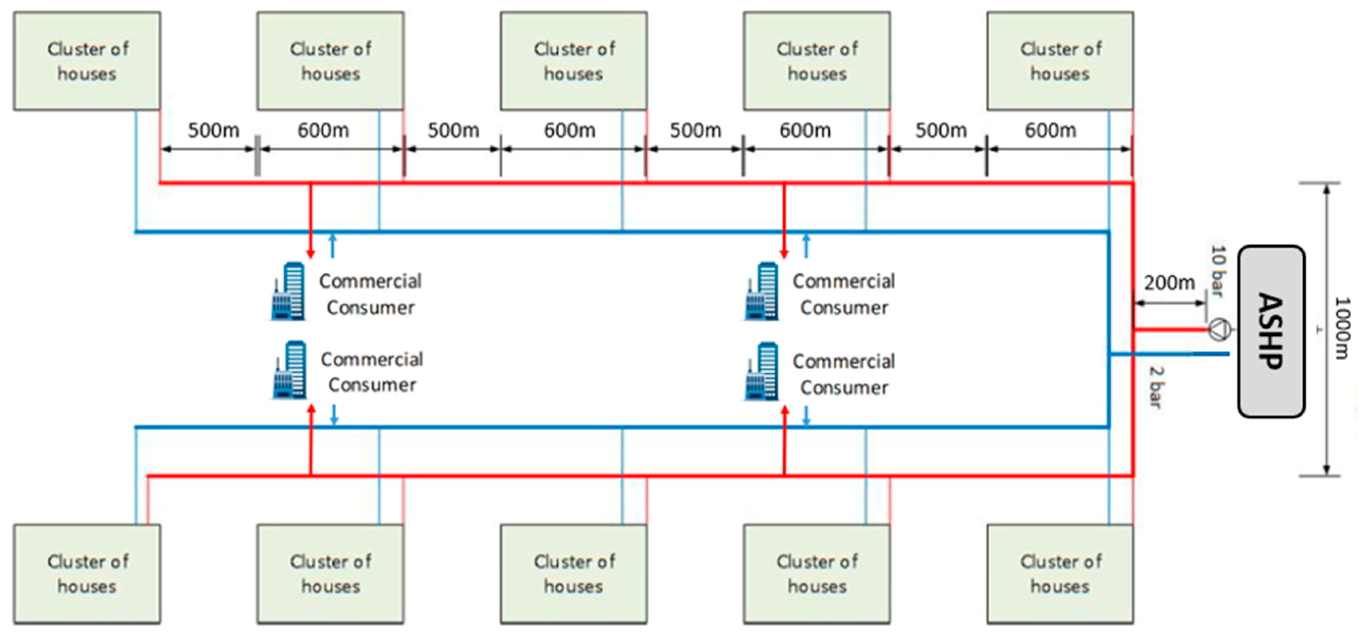


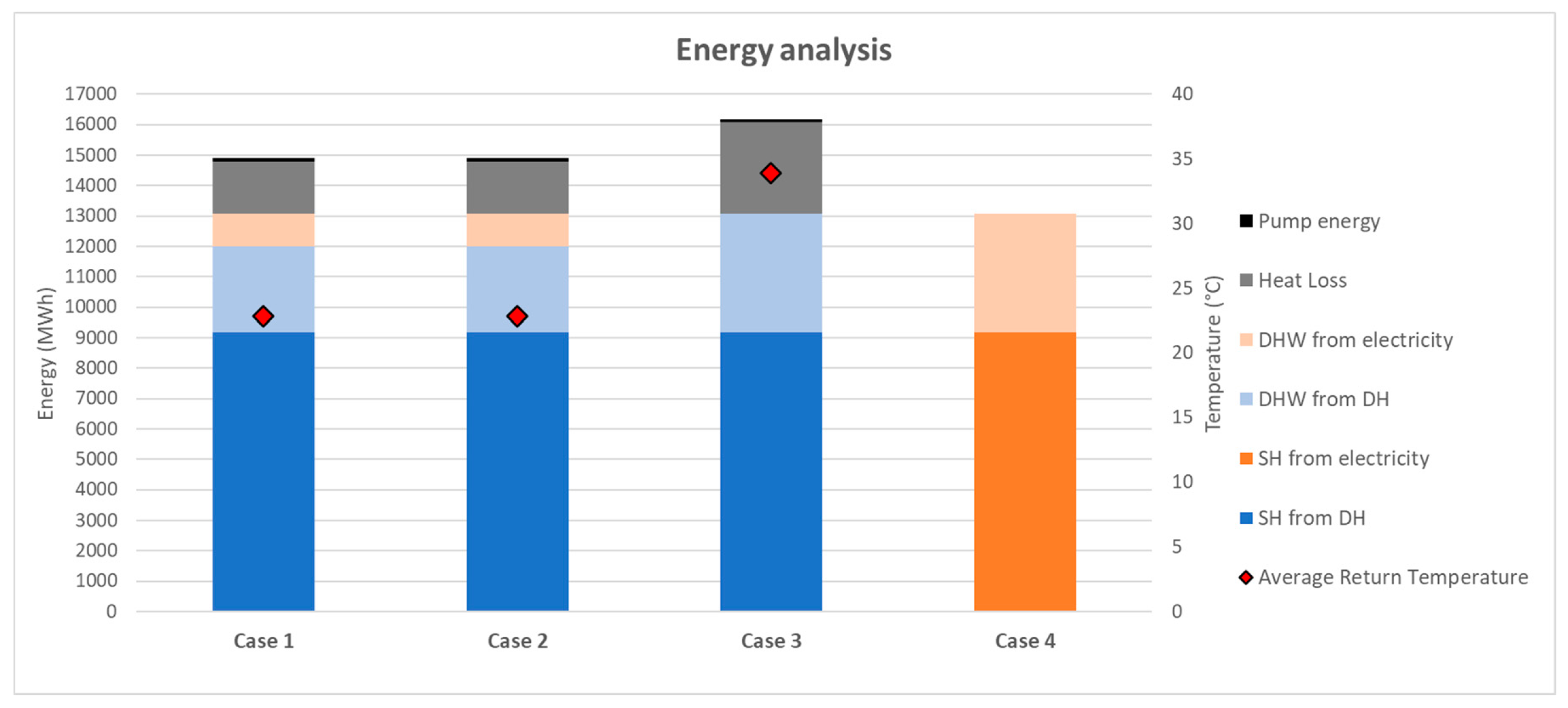

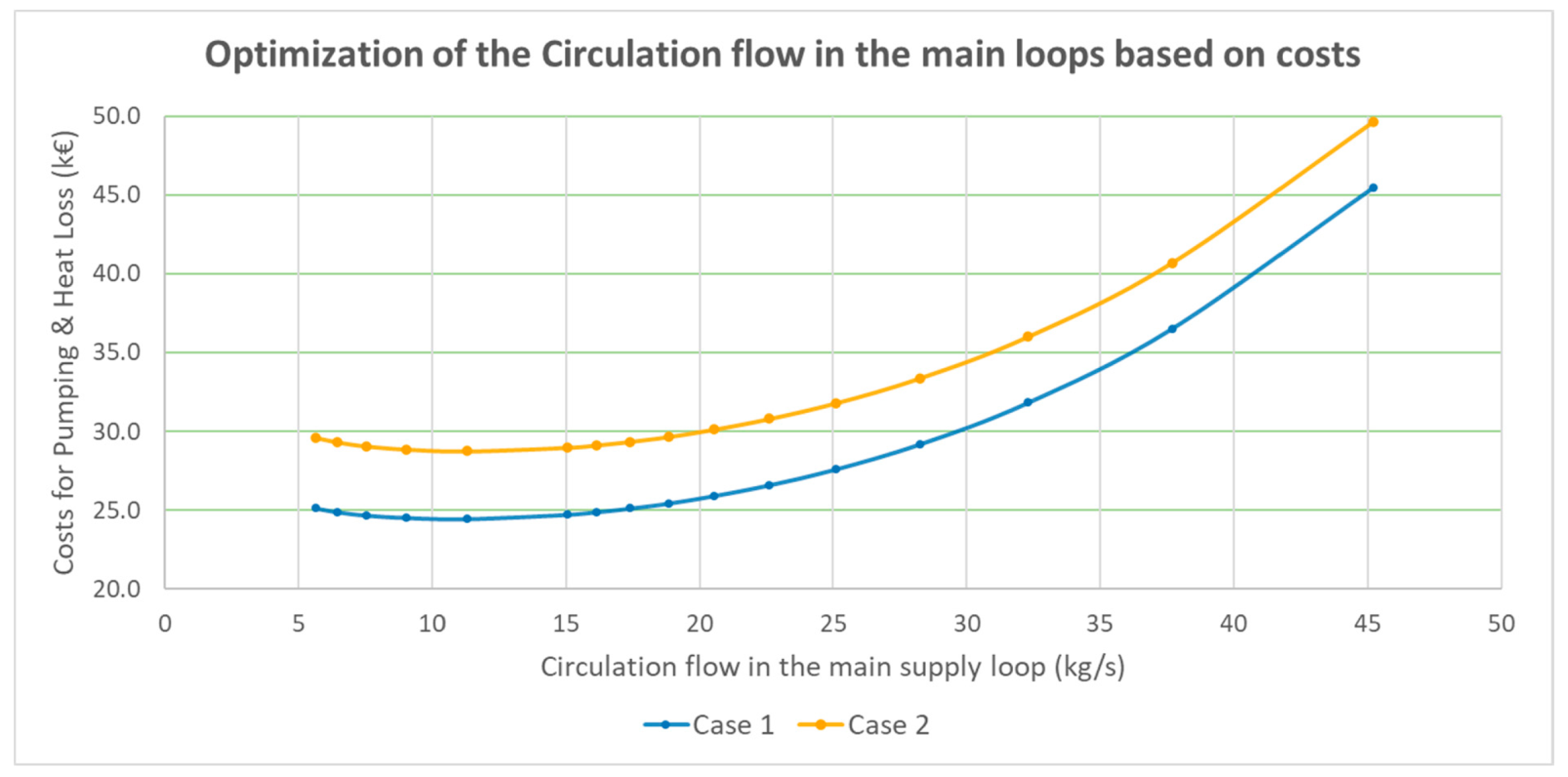

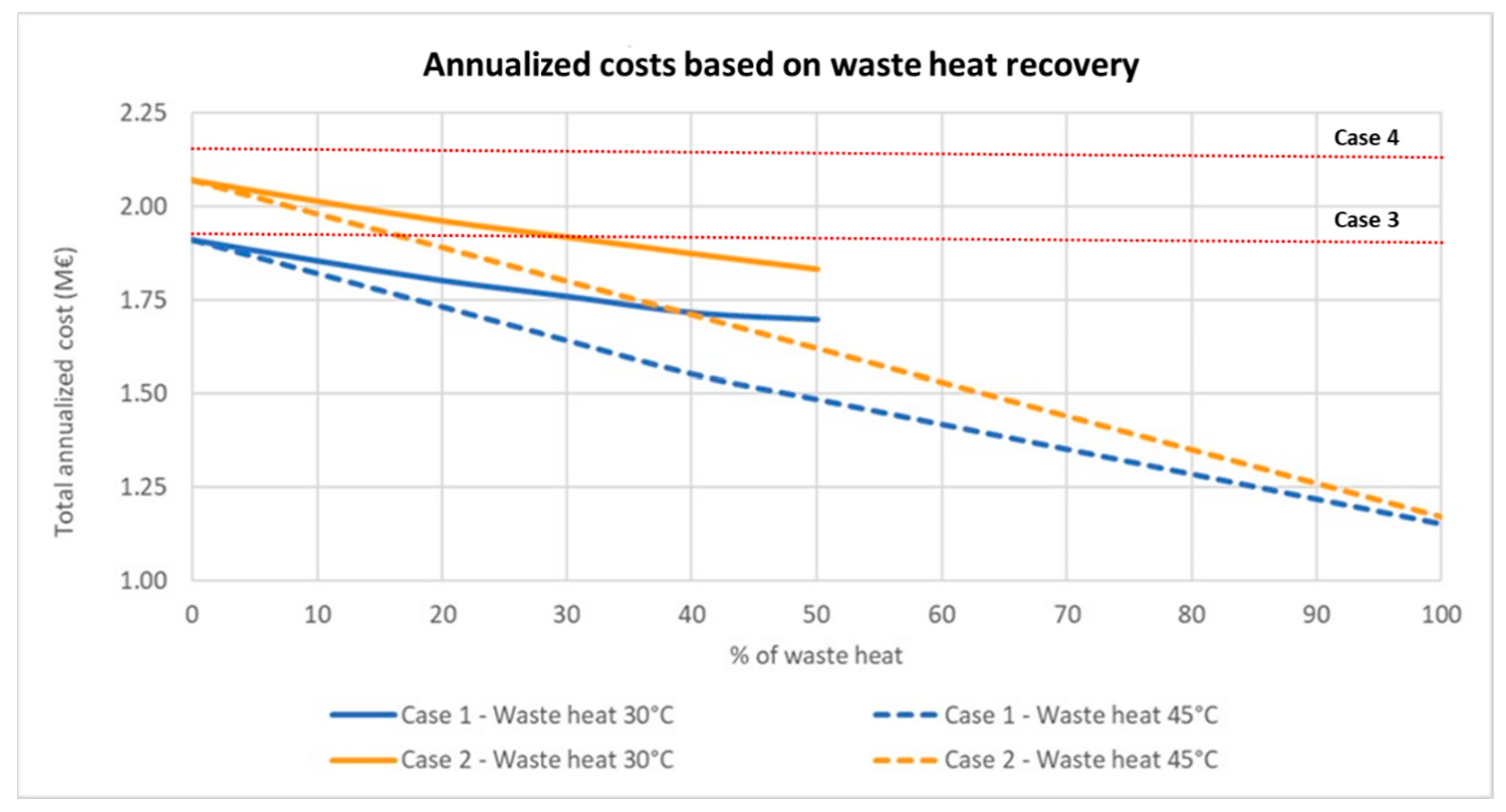
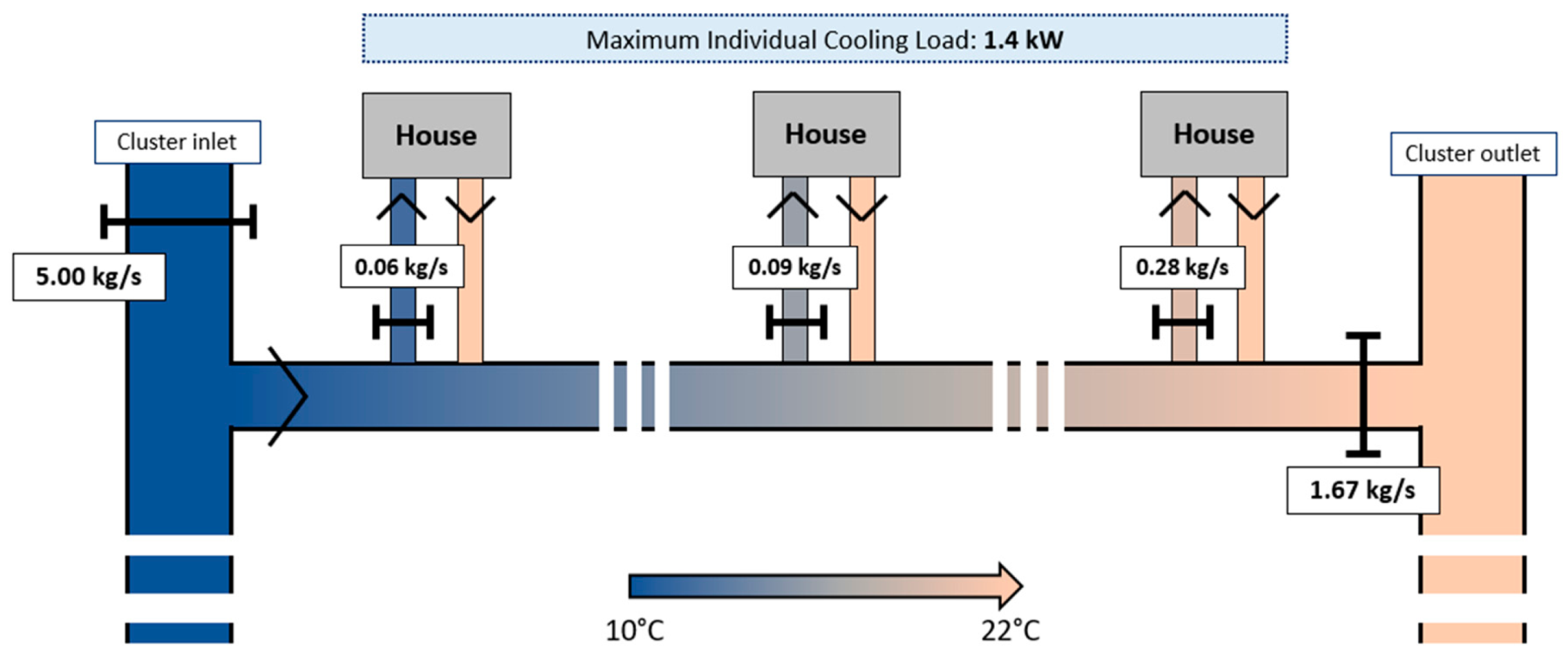
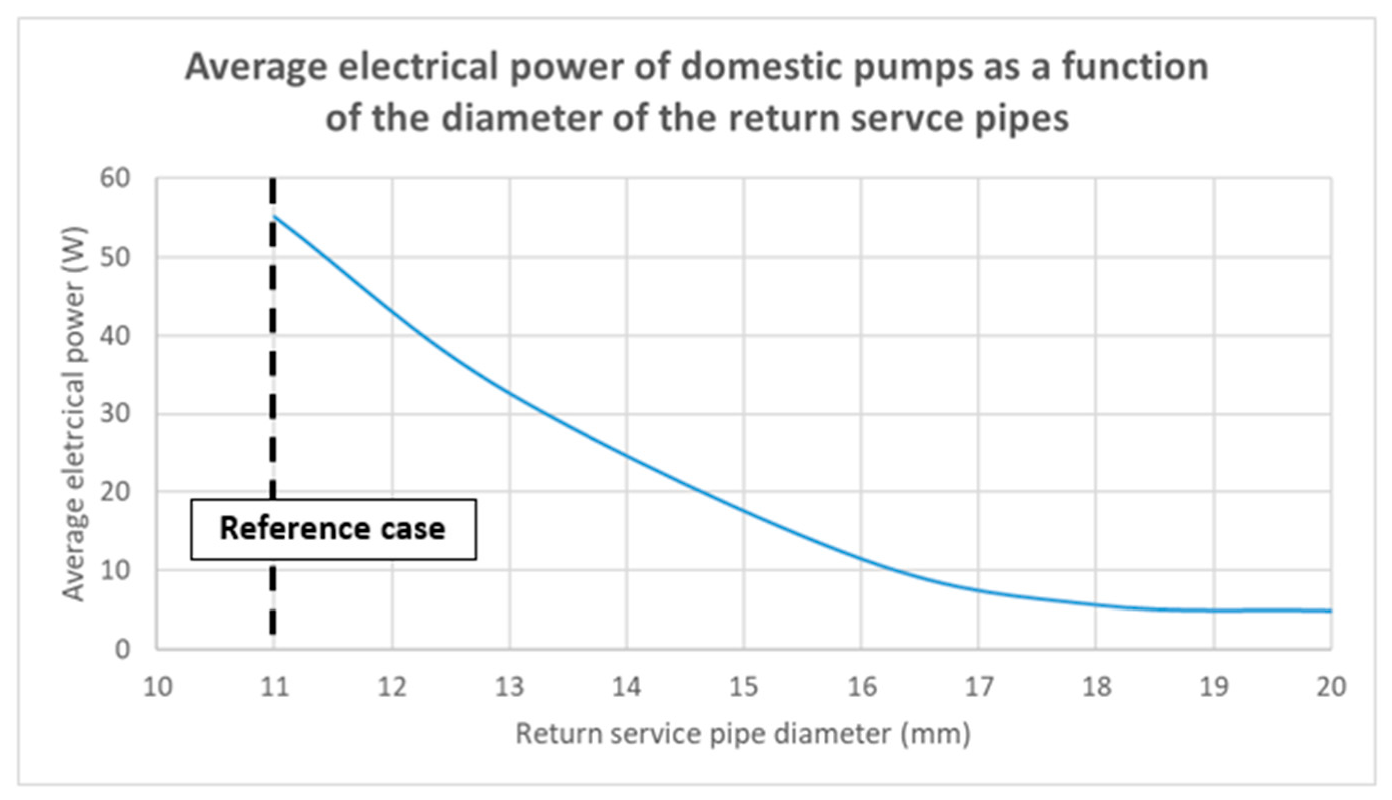
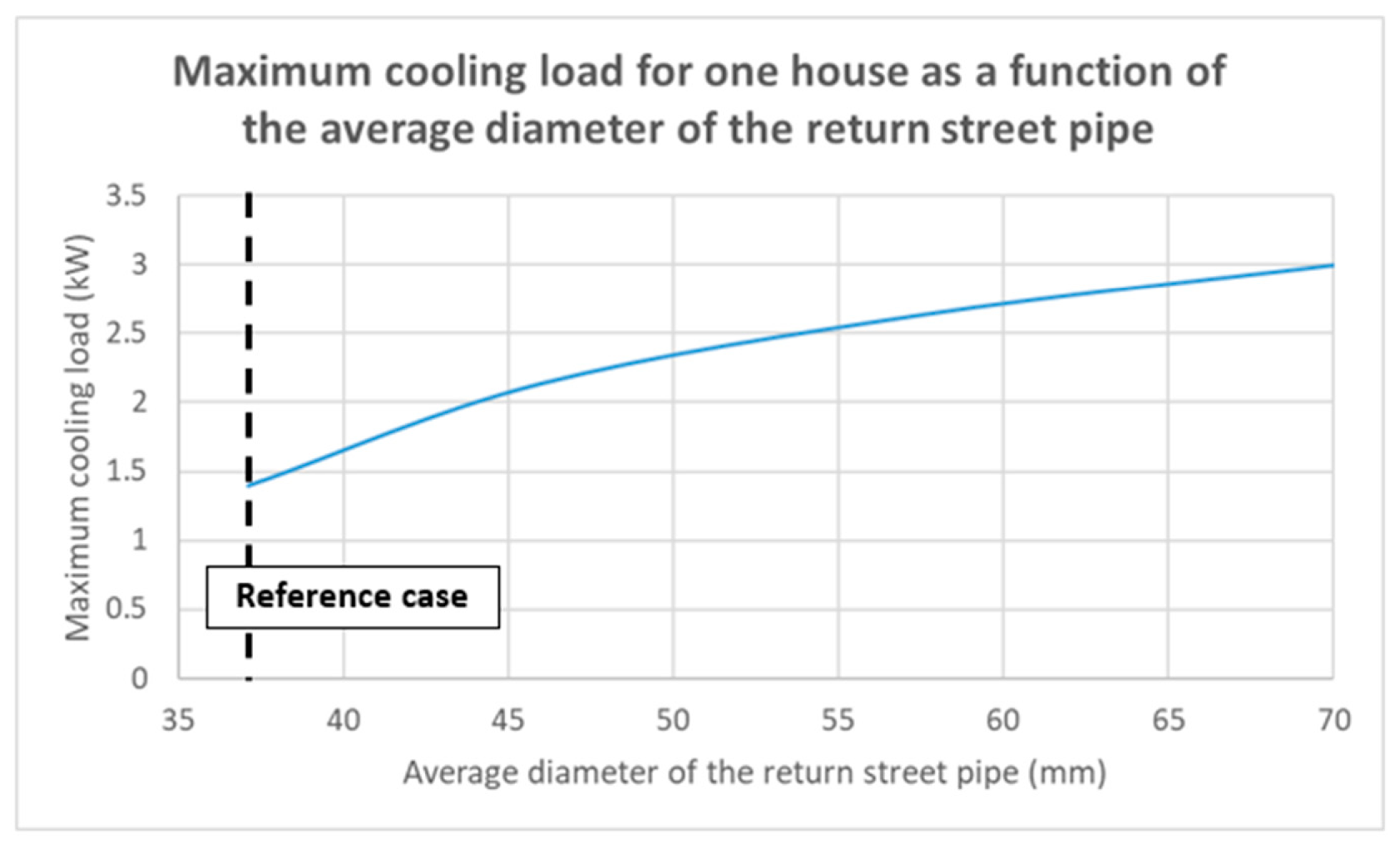
| Residential House | Commercial Building | Large ASHP | Large WSHP Heat Source at 12 °C | Large WSHP Heat Source at 30 °C | ||
|---|---|---|---|---|---|---|
| Yearly COP | - | 3.2 | 3.8 | 4.1 | 4.6 | 6.2 |
| Investment | k€/kW | 3.33 | 1.11 | 1.06 | 1.30 | 1.14 |
| Fixed O&M | €/kW/year | - | - | 2 | 2 | 2 |
| Variable O&M | €/kWh | 0.090 | 0.080 | 0.073 | 0.066 | 0.049 |
| Lifetime | year | 18 | 18 | 25 | 25 | 25 |
| Double Loop Network | Tree Network | Individual Heat Pumps | ||
|---|---|---|---|---|
| Pipe costs | €/m | 270 | 260 | - |
| Micro tank | € | 400 | - | - |
| Electricity price | €/kWh | 0.3 | ||
| Individual House | Individual Commercial Building | ||
|---|---|---|---|
| Number | - | 1500 | 4 |
| Floor area | m2 | 200 | 60,000 |
| SH peak demand | W/m2 | 15 | 15 |
| SH yearly consumption | kWh/m2 | 17 | 17 |
| DHW yearly consumption | kWh/m2 | 13 | - |
| SC yearly consumption | kWh/m2 | - | 30 |
| Double Loop—Cluster | Double Loop—Main Loop | Tree—Cluster | Tree—Distribution Network | ||
|---|---|---|---|---|---|
| Pressure gradient | Pa/m | 570 | 80 | 98 | 67 |
| Design mass flow | kg/s | 5.4 | 96.4 | 3.6 | 64.3 |
| Maximum velocity | m/s | 1.94 | 1.78 | 0.74 | 1.50 |
| Double Loop | Tree | ||||
|---|---|---|---|---|---|
| Winter | Summer | Winter | Summer | ||
| Supply temperature | °C | 45 | 45 | 55 | 55 |
| Return temperature | °C | 25 | 15 | 25 | 33 |
| Pipe burial depth | m | 1 | |||
| Soil temperature | °C | 8 | |||
| Soil thermal conductivity | W/mK | 0.16 | |||
| Case 1 | Case 2 | Case 3 | Case 4 | ||
|---|---|---|---|---|---|
| Heat price | €/kWh | 0.056 | 0.066 | 0.073 | - |
| Heat price with waste heat at 30 °C | €/kWh | 0.025 | 0.025 | - | - |
Publisher’s Note: MDPI stays neutral with regard to jurisdictional claims in published maps and institutional affiliations. |
© 2020 by the authors. Licensee MDPI, Basel, Switzerland. This article is an open access article distributed under the terms and conditions of the Creative Commons Attribution (CC BY) license (http://creativecommons.org/licenses/by/4.0/).
Share and Cite
Tunzi, M.; Ruysschaert, M.; Svendsen, S.; Smith, K.M. Double Loop Network for Combined Heating and Cooling in Low Heat Density Areas. Energies 2020, 13, 6091. https://doi.org/10.3390/en13226091
Tunzi M, Ruysschaert M, Svendsen S, Smith KM. Double Loop Network for Combined Heating and Cooling in Low Heat Density Areas. Energies. 2020; 13(22):6091. https://doi.org/10.3390/en13226091
Chicago/Turabian StyleTunzi, Michele, Matthieu Ruysschaert, Svend Svendsen, and Kevin Michael Smith. 2020. "Double Loop Network for Combined Heating and Cooling in Low Heat Density Areas" Energies 13, no. 22: 6091. https://doi.org/10.3390/en13226091
APA StyleTunzi, M., Ruysschaert, M., Svendsen, S., & Smith, K. M. (2020). Double Loop Network for Combined Heating and Cooling in Low Heat Density Areas. Energies, 13(22), 6091. https://doi.org/10.3390/en13226091







